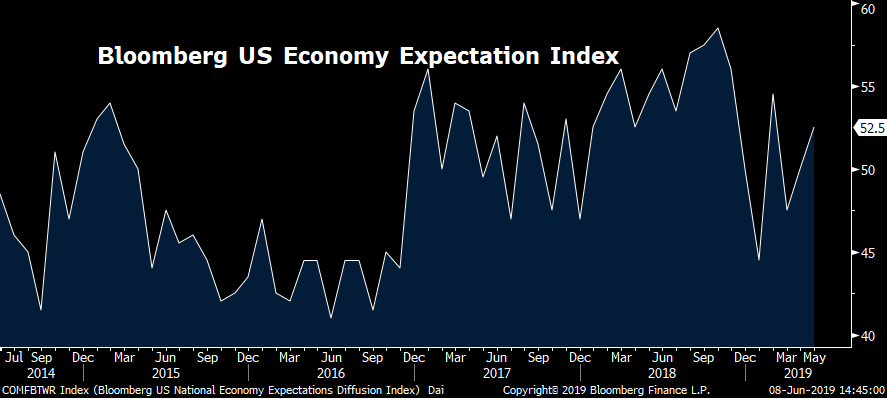
Biz Analysis
20:39, 08-Jun-2019
Fed to disappoint investors as rate cut not justified
Jimmy Zhu

Editor's note: Jimmy Zhu is the chief economist at
Fullerton Research. The article reflects the author's opinion, and not
necessarily the views of CGTN.
U.S. stocks surging, the dollar tumbling and bond yields sliding right after disappointing U.S. jobs data. The only explanation left by such a reaction in the financial markets is that traders are anticipating the Fed to cut interest rates sooner rather than later. However, there is a higher chance that the Fed will disappoint the markets in its June policy meeting in two weeks' time.
U.S nonfarm payrolls rose 75,000 in May, much slower than the revised figure of 224,000 from the previous month, data from the Labor Department show. The reading was far below earlier estimates. The hiring slowdown in May was broad-based among most sectors, from manufacturing to services. The unemployment rate remains at a 49-year low of 3.6 percent, while wage growth slowed to 3.1 percent on an annual basis, which may further limit U.S. consumers' spending power.

U.S. wage growth YoY. /Source: Bloomberg
U.S. wage growth YoY. /Source: Bloomberg
Trade tensions between the two largest economies may have started to impact on the U.S. labor market, according to the latest jobs report. Although U.S. economic activity is yet to reflect a substantial slowdown, those business owners may begin considering holding plans to expand manpower until any developments on tariffs can offer a clearer picture.
The U.S. 10-year government bond yield slid four bps on June 7 after the payrolls largely missed estimates – a decline in such securities' yields usually means either fund flow into safe havens or expectations rise on the Fed to act dovish. However, the Dow Jones index was up over one percent overnight, which suggests those positions buying the 10-year bonds simply bet the Fed to reduce the benchmark rate in the near future. Meanwhile, the U.S. three-month government bond yield dropped by seven bps this week, the most since September 2016, to 2.267 percent.
The implied probability of the Fed cutting rates this year in the futures market is currently close to 100 percent, and this could be one of the key risks for stock markets in the coming weeks. The Fed's recent beige book described economic activity growing at a "modest pace overall" from April to mid-May, an improvement from the "slight-to-moderate" pace in the prior period. Such a statement clearly demonstrated that the largest central bank in the world was not ready to ease monetary policy even as trade uncertainties weighed on. The chart below shows the Bloomberg U.S. economy expectation index continued to edge higher last month.

U.S. Economy Expectation Index. / Source: Bloomberg
U.S. Economy Expectation Index. / Source: Bloomberg
Such developments in the market while the economy isn't weak enough to justify a rate cut puts the Fed in a dilemma. If the upcoming Federal Open Market Committee (FOMC) meeting in two weeks provides signals on a willingness to cut rates in the near future, such moves actually reduce monetary room in the future if the economy enters a recession, as the U.S. benchmark rates are much lower than they were prior to the global financial crisis 10 years ago.
However, if the Fed doesn't express its willingness to act in two weeks, stock markets could be heavily penalized, as the buying in the past few days has been based on the expectation that the Fed will cut rates amid weak economic data.

Federal Reserve Chairman Jerome Powell talks with U.S. Treasury Secretary Steven Mnuchin during the G20 finance ministers and central bank governors meeting in Fukuoka, Japan, June 8, 2019. /VCG Photo
Federal Reserve Chairman Jerome Powell talks with U.S. Treasury Secretary Steven Mnuchin during the G20 finance ministers and central bank governors meeting in Fukuoka, Japan, June 8, 2019. /VCG Photo
Not all the employment-related data in the U.S. shows that the hiring pace slowed down in May. Both the ISM manufacturing and service PMI business employment indices climbed to 53.7 and 58.1 respectively. Thus, an immediate rate cut could be premature at this point.
In our best-case scenario, Jerome Powell is likely to express the Fed's willingness to ease policy, but only when economic conditions are further deteriorated by trade tensions. If the Fed offers such comments, it would signal that an imminent rate cut is not on its current agenda. On the other hand, broad-based tariffs are set to increase production costs, thus the Fed will need some time to observe its impact on U.S. inflation.

SITEMAP
Copyright © 2018 CGTN. Beijing ICP prepared NO.16065310-3
Copyright © 2018 CGTN. Beijing ICP prepared NO.16065310-3